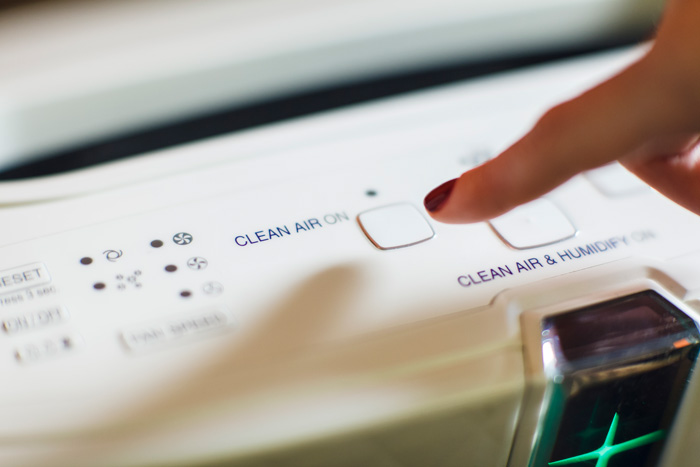Mold Resources
Introduction to Molds
Molds produce tiny spores to reproduce. Mold spores waft through the indoor and outdoor air continually. When mold spores land on a damp spot indoors, they may begin growing and digesting whatever they are growing on in order to survive. There are molds that can grow on wood, paper, carpet, and foods. When excessive moisture or water accumulates indoors, mold growth will often occur, particularly if the moisture problem remains undiscovered or un-addressed. There is no practical way to eliminate all mold and mold spores in the indoor environment; the way to control indoor mold growth is to control moisture.

Ten Things You Should Know About Mold
1. Potential health effects and symptoms associated with mold exposures include allergic reactions, asthma, and other respiratory complaints.
2. There is no practical way to eliminate all mold and mold spores in the indoor environment; the way to control indoor mold growth is to control moisture.
3. If mold is a problem in your home or school, you must clean up the mold and eliminate sources of moisture.
4. Fix the source of the water problem or leak to prevent mold growth.
5. Reduce indoor humidity (to 30-60% ) to decrease mold growth by: venting bathrooms, dryers, and other moisture-generating sources to the outside; using air conditioners and de-humidifiers; increasing ventilation; and using exhaust fans whenever cooking, dishwashing, and cleaning.
6. Clean and dry any damp or wet building materials and furnishings within 24-48 hours to prevent mold growth.
7. Clean mold off hard surfaces with water and detergent, and dry completely. Absorbent materials such as ceiling tiles, that are moldy, may need to be replaced.
8. Prevent condensation: Reduce the potential for condensation on cold surfaces (i.e., windows, piping, exterior walls, roof, or floors) by adding insulation.
9. In areas where there is a perpetual moisture problem, do not install carpeting (i.e., by drinking fountains, by classroom sinks, or on concrete floors with leaks or frequent condensation).
10. Molds can be found almost anywhere; they can grow on virtually any substance, providing moisture is present. There are molds that can grow on wood, paper, carpet, and foods.
Asthma and Mold
Molds can trigger asthma episodes in sensitive individuals with asthma. People with asthma should avoid contact with or exposure to molds.
- Allergy & Asthma Network/Mothers of Asthmatics (AAN/MA): 800-878-4403; https://allergyasthmanetwork.org/
- American Academy of Allergy, Asthma & Immunology (AAAAI): www.aaaai.org
- American Lung Association: 1-800-LUNG-USA (1-800-586-4872); http://www.lungusa.org/
- Asthma & Allergy Foundation of America: 800-7ASTHMA; http://www.aafa.org/
- Canada Mortgage & Housing Corporation “Fighting Mold – The Homeowner’s Guide”
- National Institute of Allergy and Infectious Diseases: http://www.niaid.nih.gov/
- National Jewish Medical and Research Center: 800-222-LUNG (5864)
Floods/Flooding
Mold growth may be a problem after flooding. EPA’s Fact Sheet: Flood Cleanup: Avoiding Indoor Air Quality Problems- discusses steps to take when cleaning and repairing a home after flooding. Excess moisture in the home is cause for concern about indoor air quality primarily because it provides breeding conditions for microorganisms. This fact sheet provides tips to avoid creating indoor air quality problems during cleanup. U.S. EPA, EPA Document Number 402-F-93-005, August 1993.
Health and Mold
Some people are sensitive to molds. For these people, exposure to molds can cause symptoms such as nasal stuffiness, eye irritation, wheezing, or skin irritation. Some people, such as those with serious allergies to molds, may have more severe reactions. Severe reactions may occur among workers exposed to large amounts of molds in occupational settings, such as farmers working around moldy hay. Severe reactions may include fever and shortness of breath. Some people with chronic lung illnesses, such as obstructive lung disease, may develop mold infections in their lungs.
EPA’s publication, Indoor Air Pollution: An Introduction for Health Professionals, assists health professionals (especially the primary care physician) in the diagnosis of patient symptoms that could be related to an indoor air pollution problem. It addresses the health problems that may be caused by contaminants encountered daily in the home and office. Organized according to pollutant or pollutant groups such as environmental tobacco smoke, VOCs, biological pollutants, and sick building syndrome, this booklet lists key signs and symptoms from exposure to these pollutants, provides a diagnostic checklist and quick reference summary, and includes suggestions for remedial action.
Also includes references for information contained in each section. This booklet was developed by the American Lung Association, the American Medical Association, the U.S. Consumer Product Safety Commission, and the EPA. EPA Document Reference Number 402-R-94-007, 1994.
Allergic Reactions – excerpted from Indoor Air Pollution: An Introduction for Health Professionals section on: Animal Dander, Molds, Dust Mites, Other Biologicals.
“A major concern associated with exposure to biological pollutants is allergic reactions, which range from rhinitis, nasal congestion, conjunctival inflammation, and urticaria to asthma. Notable triggers for these diseases are allergens derived from house dust mites; other arthropods, including cockroaches; pets (cats, dogs, birds, rodents); molds; and protein-containing furnishings, including feathers, kapok, etc. In occupational settings, more unusual allergens (e.g., bacterial enzymes, algae) have caused asthma epidemics. Probably most proteins of non-human origin can cause asthma in a subset of any appropriately exposed population.”

Homes and Molds
The EPA publication, “A Brief Guide to Mold, Moisture, and Your Home”, and Spanish (PDF, 20 pp, 796KB). This Guide provides information and guidance for homeowners and renters on how to clean up residential mold problems and how to prevent mold growth.
Biological Pollutants in Your Home – This document explains indoor biological pollution, health effects of biological pollutants, and how to control their growth and buildup. One third to one-half of all structures have damp conditions that may encourage the development of pollutants such as molds and bacteria, which can cause allergic reactions — including asthma — and spread infectious diseases. Describes corrective measures for achieving moisture control and cleanliness. This brochure was prepared by the American Lung Association and the U.S. Consumer Product Safety Commission. The publication was updated by CPSC in 1997
Moisture Control
Water in your home can come from many sources. Water can enter your home by leaking or by seeping through basement floors. Showers or even cooking can add moisture to the air in your home. The amount of moisture that the air in your home can hold depends on the temperature of the air. As the temperature goes down, the air is able to hold less moisture. This is why, in cold weather, moisture condenses on cold surfaces (for example, drops of water form on the inside of a window). This moisture can encourage biological pollutants to grow.
There are many ways to control moisture in your home:
- Fix leaks and seepage. If water is entering the house from the outside, your options range from simple landscaping to extensive excavation and waterproofing. (The ground should slope away from the house.) Water in the basement can result from the lack of gutters or a water flow toward the house. Water leaks in pipes or around tubs and sinks can provide a place for biological pollutants to grow.
- Use exhaust fans in bathrooms and kitchens to remove moisture to the outside (not into the attic). Vent your clothes dryer to the outside.
- Turn off certain appliances (such as humidifiers or kerosene heaters) if you notice moisture on windows and other surfaces.
- Use dehumidifiers and air conditioners, especially in hot, humid climates, to reduce moisture in the air, but be sure that the appliances themselves don’t become sources of biological pollutants.
- Raise the temperature of cold surfaces where moisture condenses. Use insulation or storm windows. (A storm window installed on the inside works better than one installed on the outside.) Open doors between rooms (especially doors to closets which may be colder than the rooms) to increase circulation. Circulation carries heat to the cold surfaces. Increase air circulation by using fans and by moving furniture from wall corners to promote air and heat circulation. Be sure that your house has a source of fresh air and can expel excessive moisture from the home.
- Put a plastic cover over dirt in crawlspaces to prevent moisture from coming in from the ground. Be sure crawlspaces are well-ventilated.
- Pay special attention to carpet on concrete floors. Carpet can absorb moisture and serve as a place for biological pollutants to grow. Use area rugs which can be taken up and washed often. In certain climates, if carpet is to be installed over a concrete floor, it may be necessary to use a vapor barrier (plastic sheeting) over the concrete and cover that with sub-flooring (insulation covered with plywood) to prevent a moisture problem.
- Moisture problems and their solutions differ from one climate to another. The Northeast is cold and wet; the Southwest is hot and dry; the South is hot and wet, and the Western Mountain states are cold and dry. All of these regions can have moisture problems. For example, evaporative coolers used in the Southwest can encourage the growth of biological pollutants. In other hot regions, the use of air conditioners which cool the air too quickly may prevent the air conditioners from running long enough to remove excess moisture from the air. The types of construction and weatherization for the different climates can lead to different problems and solutions.
Moisture on Windows
Your humidistat is set too high if excessive moisture collects on windows and other cold surfaces. Excess humidity for a prolonged time can damage walls especially when outdoor air temperatures are very low. Excess moisture condenses on window glass because the glass is cold. Other sources of excess moisture besides overuse of a humidifier may be long showers, running water for other uses, boiling or steaming in cooking, plants, and drying clothes indoors. A tight, energy efficient house, holds more moisture inside; you may need to run a kitchen or bath ventilating fan sometimes or open a window briefly. Storm windows and caulking around windows keep the interior glass warmer and reduce condensation of moisture there.
Humidifiers are not recommended for use in buildings without proper vapor barriers because of potential damage from moisture buildup. Consult a building contractor to determine the adequacy of the vapor barrier in your house. Use a humidity indicator to measure the relative humidity in your house. The American Society of Heating and Air Conditioning Engineers (ASHRAE) recommends these maximum indoor humidity levels.

Outdoor Recommended Indoor Temperature Relative Humidity
| +20º F. | 35% |
| +10º F. | 30% |
| 0º F. | 25% |
| -10º F. | 20% |
| -20º F. | 15% |
Source: Anne Field, Extension Specialist, Emeritus, with reference from the Association for Home Appliance Manufacturers (http://www.aham.org/).
How to Identify the Cause of a Mold and Mildew Problem
Mold and mildew are commonly found on the exterior wall surfaces of corner rooms in heating climate locations. An exposed corner room is likely to be significantly colder than adjoining rooms so that it has a higher relative humidity (RH) than other rooms at the same water vapor pressure. If mold and mildew growth are found in a corner room, then relative humidity next to the room surfaces is above 70%. However, is the RH above 70% at the surfaces because the room is too cold or because there is too much moisture present (high water vapor pressure)?
The amount of moisture in the room can be estimated by measuring both temperature and RH at the same location and at the same time. Suppose there are two cases. In the first case, assume that the RH is 30% and the temperature is 70oF in the middle of the room. The low RH at that temperature indicates that the water vapor pressure (or absolute humidity) is low.
The high surface RH is probably due to room surfaces that are “too cold.” Temperature is the dominating factor, and control strategies should involve increasing the temperature at cold room surfaces.
In the second case, assume that the RH is 50% and the temperature is 70oF in the middle of the room. The higher RH at that temperature indicates that the water vapor pressure is high and there is a relatively large amount of moisture in the air. The high surface RH is probably due to air that is “too moist.” Humidity is the dominating factor, and control strategies should involve decreasing the moisture content of the indoor air.
You Should Consider Having the Air Ducts in Your Home Cleaned If:
There is substantial visible mold growth inside hard surface (e.g., sheet metal) ducts or on other components of your heating and cooling system. There are several important points to understand concerning mold detection in heating and cooling systems:
- Many sections of your heating and cooling system may not be accessible for a visible inspection, so ask the service provider to show you any mold they say exists.
- You should be aware that although a substance may look like mold, a positive determination of whether it is mold or not can be made only by an expert and may require laboratory analysis for final confirmation. For about $50, some microbiology laboratories can tell you whether a sample sent to them on a clear strip of sticky household tape is mold or simply a substance that resembles it.
- If you have insulated air ducts and the insulation gets wet or moldy it cannot be effectively cleaned and should be removed and replaced.
- If the conditions causing the mold growth in the first place are not corrected, mold growth will recur.
Indoor Air Regulations and Mold
Standards or Threshold Limit Values (TLVs) for airborne concentrations of mold, or mold spores, have not been set. Currently, there are no EPA regulations or standards for airborne mold contaminants.
